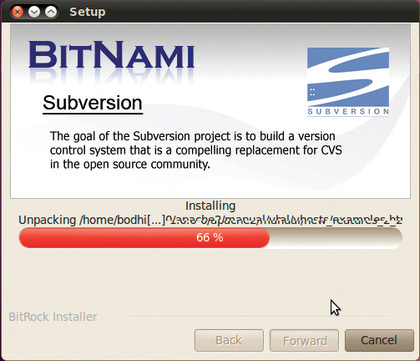Best free cross-platform software
Apps you can use on Linux, Windows and OS X
Want to deploy a web app, but don't want to spend hours setting up servers to deploy that software?
Take a look at BitNami. The project produces ready-to-use stacks of popular web apps, such as Drupal, Joomla, Moodle, phpBB, Trac, Redmine, SugarCRM, Subversion, WordPress and more.

DEVELOPING: Bitnami stacks are also available in a virtual machine
All the BitNami stacks can be deployed on Linux and Windows, as well as Intel- and PPC-based Macs. BitNami stacks are different from native installers, in that they come equipped with their own servers, software and libraries so as to not interfere with the ones installed on your system.
For example, a WordPress stack will have the WordPress web app, and also the MySQL database to manage data, Apache to serve the pages, and phpMyAdmin to administer MySQL.
All BitNami stacks have a BIN extension and a similar installation procedure. Typically, you should make the stack executable with:
chmod 755 foo-bar-stack.bin
Sign up for breaking news, reviews, opinion, top tech deals, and more.
Now run it using the following:
./foo-bar-stack.bin
This will launch its graphical installer. The installer will prompt you to select the components you want in addition to the web app itself. After installation you can manage stacks with the ctlscript file inside their respective installation directories.
The following will start the various services and the CMS:
./ctlscript start
Stop them with:
./ctlscript stop
If you've used 127.0.0.1 as the hostname, you can access the CMS by pointing your browser to http://127.0.0.1:8080, where 8080 is the default Apache port.
To run multiple stacks, run their servers on different ports. You could have WordPress on http://127.0.0.1:8080 and Drupal on http://127.0.0.1:8081, for example. The MySQL port (by default 3306) isn't part of the URL, but is used by the CMS to store and retrieve information from the database.
In addition to the various web apps, BitNami also releases infrastructure stacks that bundle the building blocks of a web server. These are useful for testing and deploying your own Web apps. There's a Ruby stack (Ruby, Rails, MySQL, Subversion) for Linux and Windows, and the LAMP, WAMP, and MAMP stacks ( Apache, MySQL, PHP, phpMyAdmin) for Linux, Windows and Mac respectively.

With almost two decades of writing and reporting on Linux, Mayank Sharma would like everyone to think he’s TechRadar Pro’s expert on the topic. Of course, he’s just as interested in other computing topics, particularly cybersecurity, cloud, containers, and coding.